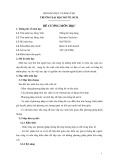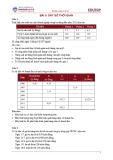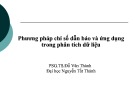Chapter 4
Probability
McGrawHill/Irwin
Copyright © 2014 by The McGrawHill Companies, Inc. All rights reserved.
Probability
4.1 Probability and Sample Spaces 4.2 Probability and Events 4.3 Some Elementary Probability Rules 4.4 Conditional Probability and
Independence
4.5 Bayes’ Theorem (Optional) 4.6 Counting Rules (Optional)
42
LO4-1: Define a probability and a sample space.
4.1 Probability and Sample Spaces
An experiment is any process of observation with
an uncertain outcome
The possible outcomes for an experiment are called
the experimental outcomes
Probability is a measure of the chance that an experimental outcome will occur when an experiment is carried out
The sample space of an experiment is the set of all
possible experimental outcomes
The experimental outcomes in the sample space are
called sample space outcomes
43
LO4-1
Probability
0 (cid:0)
1.
If E is an experimental outcome, then P(E) denotes the probability that E will occur and: Conditions P(E) (cid:0) 1 such that: If E can never occur, then P(E) = 0 If E is certain to occur, then P(E) = 1
1. The probabilities of all the experimental
outcomes must sum to 1
44
LO4-1
Assigning Probabilities to Sample Space Outcomes
1. Classical method
◦ For equally likely outcomes 1. Relative frequency method
◦ Using the long run relative frequency
1. Subjective method
◦ Assessment based on experience, expertise or
intuition
45
LO4-2: List the outcomes in a sample space and use the list to compute probabilities.
4.2 Probability and Events
An event is a set of sample space outcomes The probability of an event is the sum of
the probabilities of the sample space outcomes
If all outcomes equally likely, the probability of an event is just the ratio of the number of outcomes that correspond to the event divided by the total number of outcomes
46
LO4-3: Use elementary profitability rules to compute probabilities.
4.3 Some Elementary Probability Rules
1. Complement 2. Union
Intersection
3. 4. Addition 5. Conditional probability 6. Multiplication
47
LO4-4: Compute conditional probabilities and assess independence.
4.4 Conditional Probability and Independence
The probability of an event A, given that the
event B has occurred, is called the conditional probability of A given B ◦Denoted as P(A|B)
∩
Further, P(A|B) = P(A B) / P(B)
◦P(B) ≠ 0
48
LO4-5: Use Bayes’ Theorem to update prior probabilities to posterior probabilities (Optional).
4.5 Bayes’ Theorem
S1, S2, …, Sk represents k mutually exclusive possible states of nature, one of which must be true
P(S1), P(S2), …, P(Sk) represents the prior
probabilities of the k possible states of nature If E is a particular outcome of an experiment designed to determine which is the true state of nature, then the posterior (or revised) probability of a state Si, given the experimental outcome E, is calculated using the formula on the next slide
49
LO4-5
Bayes’ Theorem Continued
i
i
i P(E)
(cid:0) P(S E) P(S ) (cid:0) P(S =|E) i
)P(E|S P(E)
i )P(E|S
P(S )P(E|S (cid:0)
k
k
2
1
2
410
) i )+ )P(E|S )+P(S ... +P(S )P(E|S ) P(S 1
LO4-6: Use elementary counting rules to compute probabilities (Optional).
4.6 Counting Rules (Optional)
A counting rule for multiplestep
experiments
(n1)(n2)…(nk)
A counting rule for combinations
N!/n!(Nn)!
411


























